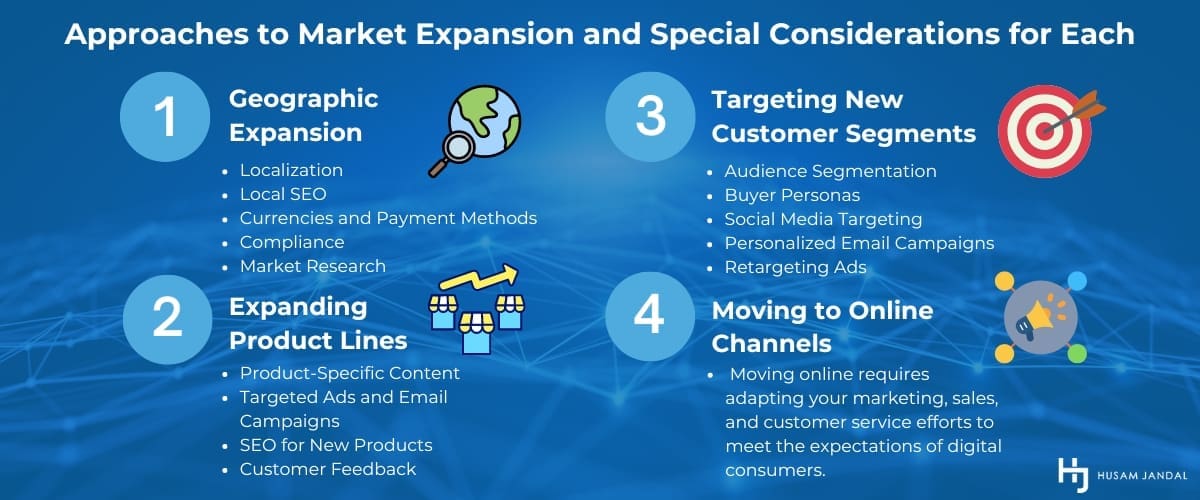 What if expanding your market was as simple as tweaking a few digital strategies? Whether you’re aiming for a new city, country, or customer segment, digital marketing can unlock the doors to massive growth if you know how to leverage it properly. On this page, I’ll walk you through all the steps involved in leveraging digital marketing for market expansion, including how to prepare for growth, expansion tactics, and digital marketing strategies you can tailor to suit your business.
What if expanding your market was as simple as tweaking a few digital strategies? Whether you’re aiming for a new city, country, or customer segment, digital marketing can unlock the doors to massive growth if you know how to leverage it properly. On this page, I’ll walk you through all the steps involved in leveraging digital marketing for market expansion, including how to prepare for growth, expansion tactics, and digital marketing strategies you can tailor to suit your business.
Laying the Foundations for Digital Marketing Expansion
A solid foundation is essential when preparing to expand your digital marketing efforts. Imagine trying to build a skyscraper without first ensuring the ground beneath it can support the weight. It may not hold up long-term. The same goes for digital marketing.
Having a solid foundation allows you to scale effectively. It ensures that the systems you rely on can handle the influx of new customers and keep everything running smoothly.
Ensure Your Tech Infrastructure is Ready
You need a robust tech infrastructure before you can leverage digital marketing for market expansion. This doesn’t just mean investing in marketing tools. It also means considering the tech from a sales and operations standpoint. Think of this as building the digital backbone of your business to handle growth efficiently across all departments.
Customer Relationship Management (CRM) Systems
A CRM system is non-negotiable if you’re serious about scaling. It allows you to store and organize customer data, track interactions, and manage leads and sales pipelines. Whether breaking into new geographic markets or introducing new products, you’ll need a system to help segment customers and create targeted marketing campaigns. Plus, it helps align your sales and marketing teams, ensuring no leads fall through the cracks.
A few common CRM tools include Zoho CRM, HubSpot, and Salesforce.
Marketing Automation Tools
Scaling your marketing efforts without automation is like trying to juggle ten balls with one hand. Tools like email marketing platforms, social media schedulers, and ad management software ensure you can consistently engage your audience without manually doing everything. Additionally, automation allows for personalized marketing, which is essential when targeting different customer segments or expanding into new markets.
Oftentimes, CRM software comes bundled with marketing automation tools, or you can purchase them as add-ons. You can also opt for an a la carte solution and use something like Zapier to manage workflows, then pair it with a job-specific tool like an email marketing program.
Analytics and Data Tracking

You can’t improve what you don’t measure, so having proper analytics tools is essential. These tools help you understand customer behavior, see which campaigns are working, and identify areas of improvement. Advanced tracking across markets allows you to make data-driven decisions when adjusting your digital marketing strategies.
For most businesses, Google Analytics is sufficient and free. However, as your business grows, you may opt for a more robust analytics program.
Sales Enablement Tools
Tech doesn’t just impact marketing. Your sales team needs the right tools to close deals faster and more effectively. Sales enablement software helps streamline communications, track leads, and generate personalized proposals, making it easier for your sales team to keep up as your customer base grows.
For example, tools like PandaDoc or DocuSign allow for quick digital contracts and streamlined proposal management, which is essential when scaling sales.
Operational Tools
Finally, operations shouldn’t be overlooked. As you grow, you’ll need to ensure your supply chain, inventory management, and customer service processes are efficient and scalable. Operational tools help ensure that your backend functions, like shipping or inventory tracking, run smoothly, allowing you to focus on customer acquisition and retention.
For instance, tools like Wrike, Trello, or Asana can help with project management, while inventory management software like QuickBooks Commerce helps streamline operations across multiple markets.
Assess Digital Readiness
Before jumping headfirst into market expansion, you must ensure your systems are prepared to handle the increased demands. This means asking the right questions about your current setup: Can your website handle more traffic? Are your analytics tools set up to measure what’s working today and what will work tomorrow? Assessing digital readiness is about ensuring your business can scale smoothly without hitting bottlenecks. For industries like finance, where regulatory compliance and customer trust are critical, implementing digital marketing strategies tailored for financial services ensures sustainable growth while maintaining credibility and adherence to industry standards.
Website Scalability
As your business grows, so will the traffic to your website. A site that’s slow or crashes under pressure can lead to lost opportunities. You’ll need to ensure that your website is optimized for scalability, which means investing in reliable hosting, using a Content Delivery Network (CDN) to handle surges in traffic, and ensuring your platform can support additional features as your business grows. This is especially crucial if you’re expanding into new regions or launching new products online.
Pro Tip: Run load tests to see how your website performs under heavy traffic. Tools like Google PageSpeed Insights or GTmetrix can help you identify areas for improvement.
Analytics and Tracking
Do you have the right data to make informed decisions? Analytics tools are crucial to understanding what’s working and where you should invest more. You should already have tracking tools like Google Analytics set up, but beyond that, you may want to consider more advanced tools for customer behavior tracking, heatmaps, and conversion rate optimization (CRO). The better your insights now, the smoother your market expansion will be.
Pro Tip: Make sure your analytics are tied to specific key performance indicators (KPIs) like bounce rates, conversion rates, and customer acquisition costs so you can track whether your expansion efforts are succeeding.
Systems Integration
One often overlooked aspect of digital readiness is whether your existing systems can talk to each other. If your CRM, email marketing tools, sales platform, and inventory management systems don’t integrate seamlessly, you’ll run into major inefficiencies. Before scaling, ensure you can centralize your data, automate workflows, and ensure all parts of the business are in sync.
Pro Tip: If you need to connect unrelated systems, consider middleware solutions like Zapier or more complex platforms like MuleSoft.
Approaches to Expansion and Special Considerations for Each
Your method of market expansion plays a significant role in shaping your digital marketing strategy. Each path requires different tactics, tools, and considerations. We’ll explore the various approaches to market expansion and their nuances first, then cover general digital marketing tactics that apply to all of them afterward so it’s easier for you to develop a tailored plan that fits your growth scenario.
Geographic Expansion
Geographic expansion involves reaching new customers in different regions or countries. This is a great way to grow your business, but it comes with its own set of challenges and considerations. Whether expanding into a new city or an entirely different country, you must tailor your digital marketing efforts to fit the new audience. Here are some key things to keep in mind:
- Localization: Adapt your website and marketing materials to the local language, culture, and preferences. This includes translating content and adjusting imagery to fit cultural norms.
- Local Search Engine Optimization (SEO): Optimize your website for local search terms and ensure your business is listed in local directories. This helps you rank higher in search engines for that specific region.
- Currencies and Payment Methods: Ensure your site supports local currencies and the payment methods commonly used in the region. This removes friction for new customers making purchases.
- Compliance: Pay attention to local regulations, like GDPR in Europe, CCPA in the USA, and PIPEDA in Canada. Compliance with data privacy laws and advertising rules helps avoid legal pitfalls and builds trust with new audiences.
- Market Research: Understand the new region’s competitive landscape and customer behavior. This will help you adjust your marketing strategy to align with the local market better.
Expanding Product Lines
When introducing new products, digital marketing is vital in getting them in front of the right audience. Whether launching a completely new product or adding variations to an existing one, you’ll need to adjust your marketing approach to create demand and excitement strategically. A few essential considerations include:
- Product-Specific Content: Create landing pages and content tailored to the new product. These pages should highlight the product’s unique value and answer potential customers’ questions.
- Targeted Ad Campaigns: Run ads that showcase the new product to your existing customer base and potential new customers. Use platforms like Google Ads or social media ads to drive traffic to your product page.
- Email Campaigns: Send personalized email campaigns to your segmented customer lists, introducing the new product and offering exclusive deals or early access. This is especially effective for re-engaging past customers.
- SEO for New Products: Optimize your new product pages with relevant keywords and update your site’s SEO to ensure search engines quickly discover your products.
- Customer Feedback: Use customer reviews, testimonials, or early product trials to build credibility and social proof. Share this feedback in your marketing materials to create trust around the new product.
Targeting New Customer Segments

Targeting new customer segments is a powerful way to grow your business by tapping into audiences you may not have reached before. This requires a careful look at your current data and tailoring your marketing efforts to meet these new groups’ specific needs and behaviors. Here’s how to approach it:
- Audience Segmentation: Use your existing data to break down your audience into new segments based on demographics, behaviors, or interests. This helps you create more personalized marketing campaigns for each group.
- Buyer Personas: Develop detailed buyer personas for these new segments. Understanding their pain points, preferences, and buying behavior will help you craft messages that resonate with them.
- Social Media Targeting: Adjust your social media strategy to align with the behavior of your new audience segments. This could mean focusing on different platforms, creating new types of content, or using targeted ads to reach them.
- Personalized Email Campaigns: Craft email campaigns that speak directly to the needs of the new segment. You can use email list segmentation to send personalized offers or product recommendations.
- Retargeting Ads: Use retargeting ads to engage visitors who’ve shown interest in your products but haven’t converted. This works well when entering new customer segments, keeping your brand top-of-mind.
Moving to Online Channels
If your business has primarily been offline, transitioning to digital channels can significantly expand your reach. Moving online requires adapting your marketing, sales, and customer service efforts to meet the expectations of digital consumers. Because this process is more in-depth than building onto an existing digital marketing strategy, I recommend following the process outlined in “Climbing the Digital Marketing Tree: Your Path to Success” if you’re building a plan from the ground up.

Additional Digital Marketing Tactics to Leverage for Market Expansion
Now that we’ve covered the specific approaches to market expansion, it’s time to explore the digital marketing tactics that apply no matter which path you choose. While these tactics are universal, it’s essential to tailor your approach to the unique needs of your expansion strategy.
For those familiar with the Digital Marketing Tree methodology, we’re now loosely focusing on ground fruit and low-hanging fruit strategies, which are essential to deliver strong returns as you expand. The key is to implement these strategies precisely, ensuring they align with the type of expansion you’re pursuing.
Paid Advertising
When expanding your market, paid search is often the most effective way to drive targeted traffic and generate leads quickly. It allows you to reach people who are actively searching for products or services like yours, making it a high-intent, high-impact strategy. Here’s what to consider:
- Paid Search Campaigns: Use platforms like Google Ads or Microsoft Advertising to bid on relevant keywords. Paid search gives you immediate visibility at the top of search results, which is crucial when entering new markets or promoting new product lines.
- Keyword Targeting: Focus on high-intent keywords that reflect what your new audience is searching for. This means investing in thorough keyword research to find terms that have good search volume but aren’t overly competitive.
- Localized Search Ads: If you’re expanding into new geographic areas, ensure your ads are localized. Include location-specific keywords and tailor your ad copy to reflect the needs of that specific region.
- Ad Assets: Use ad assets, formerly called extensions, to make your paid search ads more useful and engaging. Assets like call buttons, location info, and site links can improve click-through rates and provide additional information upfront.
- Other PPC Options: While paid search is your best bet for quick results, you can also run supporting PPC campaigns on social media to drive brand awareness or retargeting ads to re-engage users who have visited your site but didn’t convert.
- Budgeting for Paid Search: Paid search may seem costly at first, especially in competitive industries or with competitive keywords. Make sure you know your customer lifetime value (CLV) before starting so you can manage campaigns in a way that delivers a return on your marketing investment (ROMI).
SEO and Content Marketing
SEO and content marketing go hand-in-hand when expanding your business digitally. Together, they ensure your brand ranks higher on search engines and offers valuable content that engages your audience. Here’s how to leverage both for market expansion:
- Local SEO: If you’re expanding geographically, focus on local SEO by optimizing your website for region-specific keywords. Set up Google Business Profiles for each location and ensure you’re listed in relevant local directories.
- On-Page SEO: Optimize your website’s content with high-intent keywords that align with your new target audience or geographic region. Focus on essential elements like title tags, meta descriptions, and URL structure while keeping the user experience top of mind.
- Content Creation: Develop high-quality content that addresses the needs of your new market. Whether blog posts, product pages, or landing pages, the content should provide valuable information that solves customer problems or answers common questions.
- Industry Guides and Case Studies: When expanding into new markets or launching new products, long-form content like industry guides and case studies can establish your authority and build trust. This is especially effective for B2B audiences looking for detailed information before deciding.
- Link Building: Invest in a link-building strategy to earn backlinks from reputable websites as part of your SEO efforts. This boosts your domain authority, helping you rank higher for competitive search terms in your new market.
- Content Refreshing: Don’t forget about your existing content. As you expand, update old content to include new keywords, trends, and insights relevant to your new audience or product offerings. This gives you a quick SEO boost without starting from scratch.
Social Media Marketing

Social media is an essential tool for market expansion, allowing you to connect with new audiences, build brand awareness, and engage with customers in real-time. To effectively leverage social media during your expansion, you need a targeted approach that resonates with your new audience while staying true to your brand. Here are key strategies to consider:
- Tailored Campaigns: Adapt your social media campaigns to suit the behaviors and preferences of your new target audience. For example, younger audiences may prefer Instagram and TikTok, while B2B customers may be more active on LinkedIn.
- Platform-Specific Content: Each social media platform has its own strengths, so create content that aligns with the platform’s style. Use visual content like photos and videos for Instagram and Facebook, while LinkedIn may call for thought leadership articles or industry insights.
- Engagement and Community Building: Don’t just post—engage! Respond to comments, ask questions, and create polls to interact with your audience. Building an engaged community will help establish your brand in new markets and segments.
- Influencer Partnerships: Collaborating with local influencers or industry experts can help you build trust quickly in a new market. Influencers already have a loyal following, and their endorsement can lend credibility to your brand.
- Paid Social Media Ads: Use paid social ads to target specific demographics, interests, and behaviors. Social media platforms offer highly refined targeting options, making it easier to reach your new audience without wasting ad spend.
- Consistent Branding: While it’s essential to tailor your message to new audiences, maintain consistent branding across all your social channels. This ensures that your voice and visuals are recognizable, regardless of your target.
Email Marketing and Automation
Email marketing remains one of the most effective ways to nurture leads and engage customers, especially during market expansion. By using automation, you can scale your efforts without losing the personal touch that email marketing offers. Here’s how to leverage email marketing and automation effectively:
- Segmented Email Lists: As you expand, segment your email lists by region, product interest, or customer behavior. This allows you to send targeted messages that speak directly to the needs of each segment, improving open rates and engagement.
- Personalized Campaigns: Use automation tools to create personalized email campaigns. Whether it’s a welcome series for new customers in a specific region or product recommendations based on past purchases, personalized content helps build stronger relationships with your audience.
- Drip Campaigns: Implement automated drip campaigns to nurture leads over time. Drip campaigns deliver a series of emails that guide prospects through the customer journey, from initial awareness to final purchase, without requiring manual input at every step.
- Behavioral Triggers: Set up automation based on user behavior. For example, if someone abandons their cart on your website, an automated email can remind them to complete their purchase. Similarly, if a user engages with specific content, you can trigger follow-up emails tailored to their interests.
- A/B Testing: Regularly test different email subject lines, designs, and calls to action to see what resonates best with your new audience. Use automation to send variations and track results, optimizing your campaigns for higher performance.
- Nurture Leads with Education: Use email automation to provide valuable content over time. Educational emails like how-to guides, product usage tips, and industry insights can help nurture your leads and turn them into loyal customers.
Get Help Leveraging Digital Marketing for Market Expansion
The strategies outlined here are the very same tactics I use while working with the businesses I help as a digital marketing consultant. They are effective, though there are nuances to applying them. Moreover, you must tailor your approach to your business and customers. If you’d like to discuss developing a market expansion plan for your business, contact me for a complimentary consultation.
FAQs on Leveraging Digital Marketing for Market Expansion
How can I use paid search to reach new customer segments?
Paid search allows you to target high-intent keywords that potential customers are actively searching for. Start by researching relevant keywords for the new segment. Use ad copy that speaks directly to the needs of this audience to drive business growth through digital marketing. Paid search also provides advanced analytics, letting you track and optimize campaigns in real-time to maximize results.
Why is SEO important when expanding into new geographic markets?
SEO helps you appear in search results when potential customers are looking for products or services like yours. For geographic expansion, focus on local SEO by optimizing for region-specific keywords, setting up Google Business Profiles, and building backlinks from local sites. Local SEO increases your visibility in regional searches, helping you reach new audiences organically and cost-effectively.
How do I adapt my social media strategy for a new audience?
Tailor your content to the preferences and behaviors of the new audience. Research which platforms they use most and what types of content (e.g., videos, stories, or posts) resonate with them. Adjust your messaging to reflect local culture and language, and engage with your audience by responding to comments or starting conversations. Paid social ads can also help you target the right demographics.
What tools can help automate digital marketing for market expansion?
Tools like HubSpot, Salesforce, or ActiveCampaign can automate email marketing, lead nurturing, and customer relationship management (CRM). Google Analytics or Semrush help with data tracking and optimization, while social media platforms like Hootsuite or Buffer automate posting and monitoring. Automation streamlines your efforts, allowing you to scale without losing personalization.
What are some digital marketing tips for businesses expanding into new markets?
When expanding into new markets, localizing your marketing efforts is essential. Tailor your SEO strategy to include region-specific keywords, and use paid search ads to target local customers. Invest in content marketing that speaks directly to the needs of the new audience. Ensure your website is optimized for mobile and fully compliant with local regulations. These digital marketing tips will help you establish a foothold in new markets quickly and effectively.
How do I tailor content marketing to support product line expansion?
Create dedicated landing pages and blog posts that focus on the new products. These should highlight their unique benefits and address potential customer questions. Use product-specific keywords to help your content rank in search engines, and promote it through email campaigns and social media. Case studies, how-to guides, and product comparisons can further demonstrate value.
What is the role of email marketing in scaling my business?
Email marketing allows you to engage new and existing customers with personalized content. You can segment your email list based on customer behavior, location, or interest, sending targeted campaigns to drive engagement. Automation lets you nurture leads with a series of timed emails that guide them through the sales funnel. Consistent engagement through email can boost loyalty and drive sales.
How do I optimize my website for market expansion?
Ensure your site is mobile-friendly, fast, and scalable to handle increased traffic. Optimize your content for local SEO by adding region-specific keywords and creating location-specific landing pages. Integrate a CRM system to manage customer data and use analytics tools to track visitor behavior. Straightforward navigation, localized content, and a smooth user experience are crucial for retaining new visitors.
What should I look for in a CRM system when scaling my business?
Look for a CRM that supports automation, segmentation, and easy integration with your existing marketing tools. It should allow you to manage customer data, track interactions, and create targeted campaigns based on behavior and preferences. Scalability is critical—your CRM should be able to handle more leads and customers as your business grows while providing actionable insights.
How can I use digital marketing to enter international markets?
To enter international markets, localize your website by adapting language, currency, and cultural preferences. Use local SEO to rank in global search engines and run geo-targeted paid ads for visibility. Leverage social media and content marketing to engage the local audience. Ensure compliance with local regulations like GDPR in Europe or PIPEDA in Canada, and adjust your messaging to suit cultural norms.




































































